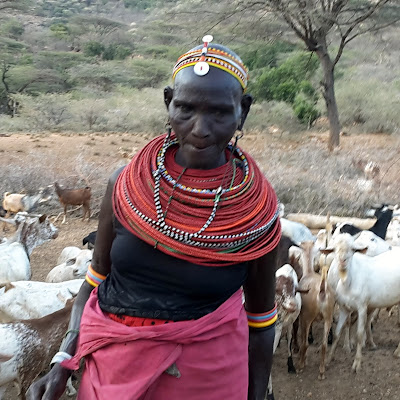 |
| Following Samburu culture, the chin of the girl on the left has been 'painted' with red ochre signifying she is eligible for marriage |
Travel is fatal to prejudice, bigotry, and narrow-mindedness.
~ Mark Twain, American author
Believers are Christ's body here on earth.
We are his hands and feet, his touch and smile, his voice and warmth.
~ Mary E. Jensen, Bible Women Speak to Us Today
 |
| It had been a year since Gloria was last at Arsim; everyone was happy to see her again! |
The Samburu are a Nilotic people of north-central Kenya that are related to but distinct from the Maasai. The Samburu are semi-nomadic pastoralists who herd mainly cattle but also keep sheep, goats, and camels. The name they use for themselves is Loikop. Although highland areas can be reached fairly easily, many areas of the lowlands remain without good roads or public services.
[from Wikipedia]
 |
| A mother and her daughter |
God gave me a sense of
wanderlust - a strong desire or impulse to wander, travel, and explore the world. In my time in Kenya, I've thoroughly enjoyed seeing so many parts of the country.
This was my first time to be in Samburu-land. It was a great opportunity to get to know Gloria better and see the place she considers home. She's been a missionary in Kenya for 23 years, 18 of which were at Arsim.
 |
| The children were also happy to see Gloria again |
 |
| Gloria is a nurse and worked at the Arsim dispensary for those 18 years. |
 |
| The three small rivers in the area are dry much of the time |
 |
| I met these two guys on one of my walks, Lemelilo and Martin |
 |
| It was nice to meet many of Gloria's friends including Julia and Vincent (on the far right), with whom we traveled and stayed. |
 |
| Marker shows the remote location of Arsim |
There are a few people left in the world who live as they've always lived,
maintaining their traditions against all odds.
These are people who want nothing to do with the modern world.
You can think they are traditionalists, maintaining their ancient culture
in the face of global homogenization, or you can think they are anachronisms,
refusing to accept modern benefits, from housing to nutrition to medicine.
Whatever your opinion, these compelling and remarkable beings
from another time are now quickly vanishing from the earth.
Whenever I get a chance, I like to go look at them.
~ Craig Nelson, Let's Get Lost
(referring to people such as the Khoikoi, Hadza, San Bushmen, and Datoga from southern Africa and Tanzania)






















































